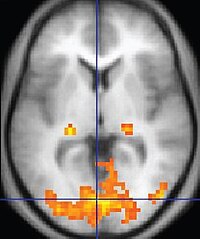
Photo from wikipedia
RATIONALE AND OBJECTIVES To assess for indirect evidence of gadoteridol retention in the deep brain nuclei of women undergoing serial screening breast MRI. METHODS This HIPAA-compliant prospective observational noninferiority imaging… Click to show full abstract
RATIONALE AND OBJECTIVES To assess for indirect evidence of gadoteridol retention in the deep brain nuclei of women undergoing serial screening breast MRI. METHODS This HIPAA-compliant prospective observational noninferiority imaging trial was approved by the IRB. From December 2016 to March 2018, 12 consented subjects previously exposed to 0-1 doses of gadoteridol (group 1) and 7 consented subjects previously exposed to ≥4 doses of gadoteridol (group 2) prospectively underwent research-specific unenhanced brain MRI including T1w spin echo imaging and T1 mapping. Inclusion criteria were: (1) planned breast MRI with gadoteridol, (2) no gadolinium exposure other than gadoteridol, (3) able to undergo MRI, (4) no neurological illness, (5) no metastatic disease, (6) no chemotherapy. Regions of interest were manually drawn in the globus pallidus, thalamus, dentate nucleus, and pons. Globus pallidus/thalamus and dentate nucleus/pons signal intensities and T1-time ratios were calculated using established methods and correlated with cumulative gadoteridol dose (mL). RESULTS All subjects were female (mean age: 50 ± 12 years) and previously had received an average of 0.5 ± 0.5 (group 1) and 5.9 ± 2.1 (group 2) doses of gadoteridol (cumulative dose: 8 ± 8 and 82 ± 31 mL, respectively), with the last dose an average of 492 ± 299 days prior to scanning. There was no significant correlation between cumulative gadoteridol dose (mL) and deep brain nuclei signal intensity at T1w spin echo imaging (p = 0.365-0.512) or T1 mapping (p = 0.197-0.965). CONCLUSION We observed no indirect evidence of gadolinium retention in the deep brain nuclei of women undergoing screening breast MRI with gadoteridol.
Journal Title: Academic radiology
Year Published: 2020
Link to full text (if available)
Share on Social Media: Sign Up to like & get
recommendations!